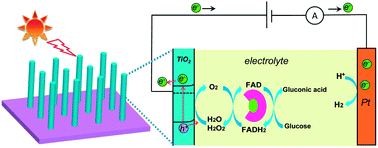Sensitive enzymatic glucose detection by TiO2 nanowire photoelectrochemical biosensors†
Abstract
Photoelectrochemical detection represents a unique signal transducing modality, where the photogenerated charge carriers are modulated by the redox reactions of molecular targets over the electrode surface. In this work, we report a novel glucose sensor based on hydrothermally-grown, single-crystalline TiO2 nanowires with surface-functionalized glucose oxidase (GOx), which can oxidize glucose to gluconic acid. The key feature of this glucose sensor design is that the photogenerated holes over the TiO2 anode are utilized to form O2, which directly serves as an efficient electron shuttling mediator between the enzymatic redox center of GOx and the sensor surface, thus leading to an increase of the photocurrent. As a proof-of-concept, the GOx-functionalized TiO2 (TiO2–GOx) nanowires exhibit a high sensitivity of ∼0.9 nM in the detection of glucose in buffer. The capability of detecting glucose in mouse serum is also demonstrated. Our work suggests the potential of developing these nanowire-based photoelectrochemical biosensors for convenient, efficient and low-cost biomarker detection and disease diagnosis.

- This article is part of the themed collection: Emerging Investigators

 Please wait while we load your content...
Please wait while we load your content...